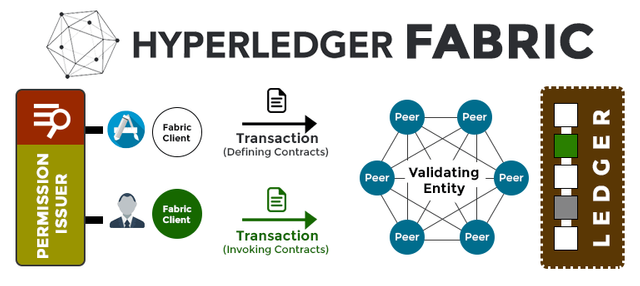Well Natives..
Here we are...
In the newest phase of the Blockchain space.
If you are here...
You probably actually care about innovation.
We look to our left and right and no longer see the abundant shilling of frivolous ICOs and greedy tech-imposters seeking quick gains.

Commonly, there are harsh perceptions fueled on emotions linked to financial gains or losses but as most of us know; Blockchain technology is to be built upon.
A bit of history...
As the popularity of Bitcoin, Ethereum and a few other derivative technologies grew, interest in applying the underlying technology of the blockchain, distributed ledger and distributed application platform to more innovative enterprise use cases also grew.
However, many enterprise use cases require performance characteristics that the permissionless blockchain technologies are unable (presently) to deliver.
In addition, in many use cases, the identity of the participants is a hard requirement, such as in the case of financial transactions where Know-Your-Customer (KYC) and Anti-Money Laundering (AML) regulations must be followed.

HYPERLEDGER FABRIC
What started the large interest in permissioned blockchain technologies such as Hyperledger?
Well...
The interest behind permissioned Blockchain technologies such as Hyperledger derived from the needs of businesses seeking cost-effective privacy where the participants are known to each other rather than anonymous and therefore fully untrusted.
Fabric is also a pluggable consensus protocol that can be tailored for different use cases and is not constrained by domain-specific languages, thus easily implemented.
Furthermore, Fabric can leverage consensus protocols that do not require a native cryptocurrency to incent costly mining or to fuel smart contract execution. Avoidance of a cryptocurrency reduces some significant risk/attack vectors, and absence of cryptographic mining operations means that the platform can be deployed with roughly the same operational cost as any other distributed system.
Why are the popular public blockchains not suitable for business use cases?
Another great question...
Popular public blockchains are not suitable for business use cases for many reasons.
The top reasons are surrounding the necessity of the identity of the participants as a hard requirement.
For enterprise use, we need to consider the following requirements:
- Participants must be identified/identifiable
- Networks need to be permissioned
- High transaction throughput performance
- Low latency of transaction confirmation
- Privacy and confidentiality of transactions and data pertaining to business transactions
Also, Fabric enables innovation, versatility and optimization for a broad range of industry use cases and support smart contracts authored in general-purpose programming languages.
R3 Corda [ The Corda Platform ] is another great example of a technology that has plug-and-play ease in regard to enterprise solutions.
https://www.r3.com/corda-platform/
What programming languages can be used to write smart contracts on Hyperledger Fabric?
Smart contracts on Hyperledger Fabric can be authored in general-purpose programming languages such as Java, Go and Node.js
What does it mean to have support for “pluggable consensus protocols”?
To have support for "pluggable consensus protocols" means that programmers can utilize languages that they already know vs. having to learn new ones. This means that most enterprises already have the skill set needed to develop smart contracts, and no additional training to learn a new language or DSL is needed.
This enables the platform to be more effectively customized to fit particular use cases and trust models.
For instance, when deployed within a single enterprise, or operated by a trusted authority, fully byzantine fault tolerant consensus might be considered unnecessary and an excessive drag on performance and throughput.
In situations such as that, a crash fault-tolerant (CFT) consensus protocol might be more than adequate whereas, in a multi-party, decentralized use case, a more traditional byzantine fault tolerant (BFT) consensus protocol might be required.
It looks like this...

The bottom line...
Fabric's pluggable consensus protocols ensure that the main program can use easily added modular programs to facilitate customized consensus code to fit specific use cases.
What does this mean for you ?
A good understanding of Hyperledger will be needed within business infrastructure for the unseen future.
This knowledge makes these blockchain developers and project managers a high commodity going forward.
Cheers,
Native Loup
Hi! I am a robot. I just upvoted you! I found similar content that readers might be interested in:
https://hyperledger-fabric.readthedocs.io/en/release-1.3/whatis.html
Downvoting a post can decrease pending rewards and make it less visible. Common reasons:
Submit
Congratulations! This post has been upvoted from the communal account, @minnowsupport, by NativeLoup from the Minnow Support Project. It's a witness project run by aggroed, ausbitbank, teamsteem, someguy123, neoxian, followbtcnews, and netuoso. The goal is to help Steemit grow by supporting Minnows. Please find us at the Peace, Abundance, and Liberty Network (PALnet) Discord Channel. It's a completely public and open space to all members of the Steemit community who voluntarily choose to be there.
If you would like to delegate to the Minnow Support Project you can do so by clicking on the following links: 50SP, 100SP, 250SP, 500SP, 1000SP, 5000SP.
Be sure to leave at least 50SP undelegated on your account.
Downvoting a post can decrease pending rewards and make it less visible. Common reasons:
Submit
Congratulations @nativeloup! You have completed the following achievement on the Steem blockchain and have been rewarded with new badge(s) :
Click here to view your Board
If you no longer want to receive notifications, reply to this comment with the word
STOPDownvoting a post can decrease pending rewards and make it less visible. Common reasons:
Submit